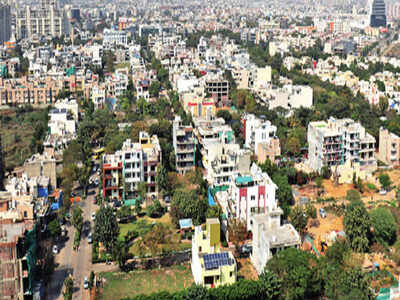
GURUGRAM: The city has been losing its water bodies because of development projects over several decades. According to forest department records, there were nearly 118 bunds in Gurugram and nearby areas before 1958, but only around 30 of them have survived to the present day.
In 2017, the district administration conducted a survey, which revealed that 63 bunds were constructed during the British era in Gurugram, out of which only four exist now. While there are still many natural bunds in the city, most of them are in prime locations and are being targeted by the local land mafia.
Some parts of natural bunds in Ghata, Wazirabad and Chakkarpur have been encroached upon, while others have been taken over by the government for development projects. For instance, Jharsa bund, which was once the biggest bund in the city, was carved out for a hospital and roads. A CRPF camp came up on Kadipur bund. Nathupur bund, which was located near Ambience Mall, was destroyed as a residential project and the mall were built on it six years ago. The foothills where Ghata bund lay were encroached on by high-rise buildings.
Behrampur bund, which was a 2km-long bund near Ghata, was destroyed due to the development of housing projects and roads in the area. Manesar bund, once spread across 7km, is no more, with the town of Manesar built on it.
“Losing of bunds to development projects has been the tradition in this city for the last three decades now. Forest department has neglected the protection of these bunds. When the town and country planning department plans a project, it doesn’t pay any attention to water bodies in the area. We have to give clearance for development projects,” admitted a senior official from the forest department.
With bunds being encroached on over the years and stormwater channels being concretised, rainwater has no place to go, resulting in flooding every monsoon. “Each bund has a small water body attached to it, which recharges the groundwater table. As water channels get choked up because of development projects, water fails to flow into the bund, and thus the water body becomes redundant and dries up, or is choked with sewage. The surface hydrology is disturbed. Gurugram gets flooded in the rainy season because it is losing its bunds rapidly,” the official added.
Environmental activists alleged that apart from natural bunds, several water bodies in the city are at risk and no action has been taken to save them either. “Natural bunds like those in Ghata, Wazirabad and Ghamroj are gifts to the city. But, they have been destroyed in the name of development projects,” Vivek Kamboj, a city-based environmentalist, told TOI.
According to a report submitted by the administration to the National Green Tribunal, there are 826 water bodies in Gurugram. As many as 20% of these are at risk due to discharge of untreated sewage, industrial effluents or water, environmentalists said.
In 2017, the district administration conducted a survey, which revealed that 63 bunds were constructed during the British era in Gurugram, out of which only four exist now. While there are still many natural bunds in the city, most of them are in prime locations and are being targeted by the local land mafia.
Some parts of natural bunds in Ghata, Wazirabad and Chakkarpur have been encroached upon, while others have been taken over by the government for development projects. For instance, Jharsa bund, which was once the biggest bund in the city, was carved out for a hospital and roads. A CRPF camp came up on Kadipur bund. Nathupur bund, which was located near Ambience Mall, was destroyed as a residential project and the mall were built on it six years ago. The foothills where Ghata bund lay were encroached on by high-rise buildings.
Behrampur bund, which was a 2km-long bund near Ghata, was destroyed due to the development of housing projects and roads in the area. Manesar bund, once spread across 7km, is no more, with the town of Manesar built on it.
“Losing of bunds to development projects has been the tradition in this city for the last three decades now. Forest department has neglected the protection of these bunds. When the town and country planning department plans a project, it doesn’t pay any attention to water bodies in the area. We have to give clearance for development projects,” admitted a senior official from the forest department.
With bunds being encroached on over the years and stormwater channels being concretised, rainwater has no place to go, resulting in flooding every monsoon. “Each bund has a small water body attached to it, which recharges the groundwater table. As water channels get choked up because of development projects, water fails to flow into the bund, and thus the water body becomes redundant and dries up, or is choked with sewage. The surface hydrology is disturbed. Gurugram gets flooded in the rainy season because it is losing its bunds rapidly,” the official added.
Environmental activists alleged that apart from natural bunds, several water bodies in the city are at risk and no action has been taken to save them either. “Natural bunds like those in Ghata, Wazirabad and Ghamroj are gifts to the city. But, they have been destroyed in the name of development projects,” Vivek Kamboj, a city-based environmentalist, told TOI.
According to a report submitted by the administration to the National Green Tribunal, there are 826 water bodies in Gurugram. As many as 20% of these are at risk due to discharge of untreated sewage, industrial effluents or water, environmentalists said.

Coronavirus outbreak
Trending Topics
LATEST VIDEOS
City
 Covid-19 spread: No religion, God call for big celebrations, says Harsh Vardhan
Covid-19 spread: No religion, God call for big celebrations, says Harsh Vardhan  Shocking: Tribal man killed, body burnt over witchcraft suspicion in Andhra Pradesh
Shocking: Tribal man killed, body burnt over witchcraft suspicion in Andhra Pradesh  On cam: Punjab girl bravely fights off bike-borne purse snatchers
On cam: Punjab girl bravely fights off bike-borne purse snatchers  Ahmedabad: Dalit woman from a village in Banaskantha district molested by six
Ahmedabad: Dalit woman from a village in Banaskantha district molested by six
More from TOI
Navbharat Times
Featured Today in Travel
Quick Links
Delhi Air PollutionHaryana Coronavirus Helpline NumberUP Coronavirus Helpline NumberBangalore TemperatureBhopal NewsCoronavirus in DelhiCoronavirus in HyderabadHyderabad RainCoronavirus symptomsCoronavirusDelhi TemperatureAditya ThackerayShiv SenaFire in MumbaiMumbai RainsArvind KejriwalBangalore FloodsSrinagar encounter
Get the app



